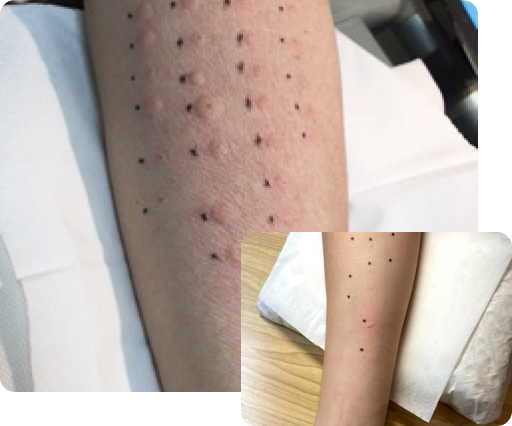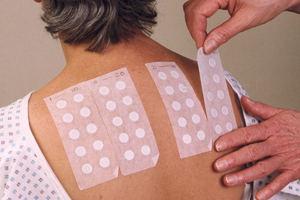Home
Food Allergy Testing Sydney
Home
Food Allergy Testing Sydney

Allergy Testing Sydney is your top choice for food allergy testing and personalised allergy management. We offer rapid results, an extensive range of food tests, expert treatment, and advanced technological solutions to ensure accuracy and reliability. Our professional support helps find effective solutions tailored to your individual needs.


Allergy Testing Sydney offers comprehensive food allergy testing through skin prick, IgE blood, or patch tests. Skin prick tests quickly and easily identify sensitivities by applying allergens to the skin and measuring reactions. IgE blood tests are designed to detect specific antibodies for an allergy and is ideal for those who cannot take a skin prick test. Patch tests are used for delayed reactions, in which allergens are applied on the skin for 48 hours. Our experts identify the relevant allergens during your first visit to ensure identification and proper management of allergies.

Stop certain medications as directed. Inform staff if you’re on beta-blockers or tricyclic antidepressants. Avoid specific nasal sprays a week before.

The doctor reviews your history and selects allergens for testing. The nurse performs the tests under supervision. Further testing may be needed based on initial results.

You’ll be tested for food allergies on both forearms to ensure comprehensive results.
Food allergy testing is a process used to identify whether a person has an allergic reaction to specific foods. It involves various methods, such as IgE blood tests, skin prick tests, and oral food challenges, to determine if the immune system reacts negatively to certain food proteins. The goal of food allergy testing is to accurately diagnose allergies so that individuals can avoid triggers and manage their condition effectively.
Allergy to food items is typically tested through a skin prick test, where potential food allergens are applied on the skin to see if there is any reaction. It can also be tested with a blood test for the presence or level of food-specific antibodies. Food allergy testing can also be done though patch tests, which apply extracts of potential food allergens to the skin and look for a reaction such as a rash, redness, or itching 48-72 hours later, are carried out to detect delayed-action allergies.
Specialists then interpret the results of these tests along with the patient’s medical history to diagnose food allergies and differentiate them from intolerances
No, food allergy testing and food intolerance testing are different. Food allergies involve the immune system and can cause severe reactions, while food intolerances typically involve digestive issues and are less serious. Testing methods vary, with allergies requiring immune-focused tests, and intolerances often identified through digestive-related assessments.
If you’re looking to get a food allergy test, we at Allergy Testing Sydney are here to help. We’ve been around for over 45 years, assisting tens of thousands of patients in improving their lives through accurate allergy identification and management. Our experienced team offers a range of tests, including IgE blood tests, skin prick tests, and more, ensuring you receive the most accurate diagnosis and personalised care.
Allergies can trigger various conditions. We provide targeted testing based on your clinical history to identify the most relevant allergens, ensuring effective treatment.


Extract Taken from www.virtualmedicalcentre.com
A RAST test measures the level of allergen-specific IgE in your blood. That is, it measures the concentration of antibodies your body has created to against a particular food allergen. Interpreting a RAST result is slightly more complicated, however. This is because not everyone with the same concentration of allergen-specific IgE in their blood will react in the same way to the presence of an allergen in vivo (that is, in the flesh).
Someone with a relatively low concentration of allergen-specific IgE may have a fairly severe reaction while someone with a higher concentration of allergen-specific IgE may not react at all — that is, they’re not truly allergic to a food even though the blood test comes out positive. (This is known as a false positive.) RAST tests have a high sensitivity and fairly low specificity, meaning that they have a low rate of false positives and a fair number of false negatives, though this varies by allergen. In general, lower rates of allergen-specific IgE are correlated with a lower chance of reacting in a double-blind food challenge or in a real-world setting, especially if skin test results are negative and if there’s been no history of reaction to a given food.
Different foods have different specific IgE levels that are considered “predictive.” Where most people with a given level of specific IgE may react to one particular food, most people with that same level of specific IgE may not react to another food. Researchers determine these threshold levels by comparing RAST test results to the results of double-blind food challenges in order to find a level of specific IgE on the blood test where a very high percentage of people are truly allergic. This means that someone whose test results “look” identical for two different foods may be considered to have a positive result for one and a negative result for the other, if the foods have different threshold levels.
Specific IgE tests are usually returned in units of micrograms per milliliter (μg/mL). Some, however, are returned on a numerical rating scale (often, but not always, from 0 to 5 or 6). On rated tests, 0 almost always indicates an exceedingly low chance of a true food allergy, while the higher numbers normally mean very strong probability of allergy and a strong likelihood of a severe reaction. Your allergist may use these results to help determine some aspects of your treatment — to see whether a child is showing signs of outgrowing a food allergy, for instance.
Visit us L7 William Bland Centre 229 Macquarie Street Sydney, NSW, 2000
Call us on (02) 9221 1511